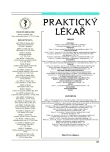Clinical significance of vitamin K for quality of bone and for calcified tissues
Authors:
J. Štěpán
Authors‘ workplace:
III. interní klinika 1. lékařské fakulty UK Praha, přednosta
prof. MUDr. Š. Svačina, DrSc.
Published in:
Prakt. Lék. 2005; 85(6): 326-330
Category:
Reviews
Overview
Vitamin K is an essential cofactor for the conversion of glutamate into gamma-carboxyglutamate. In healthy individuals dietary intake of vitamin K as phylloquinone (vitamin K-1) and menaquinone (MK-n, vitamin K-2) fills the needs for coagulation, but in 90% of the population is not sufficient for maintenance of the production of Gla-proteins in bone and vascular tissue. Unlike vitamin A and D, vitamin K is not transferred to other plasma carriers than lipoproteins. Vitamin K stimulates osteogenic and inhibits adipogenic differentiation of marrow stromal cells. Elevated levels of undercarboxylated osteocalcin, a vitamin Kdependent protein involved in bone metabolism, may result from subclinical vitamin K deficiency and are frequently observed in the elderly. In some studies, undercarboxylation of osteocalcin has been reported to be associated with an impaired bone quality and increased risk of fracture. Also, an inadequate dietary intake of vitamin K may result in undercarboxylation of vascular matrix Gla-proteins, leading to enhanced calcification of atherosclerotic lesions and an increased risk of coronary heart disease. Recent studies suggest a protective effect of menaquinone intake against coronary heart disease as well as against the deterioration of bone quality.
Key word:
coronary heart disease – fracture – lipoproteins – osteoporosis – quality of bone.
Labels
General practitioner for children and adolescents General practitioner for adultsArticle was published in
General Practitioner

2005 Issue 6
Most read in this issue
- The principle of dual effect and conscience
- Defecography in the diagnostics of anorectal dysfunctions
- Clinical significance of vitamin K for quality of bone and for calcified tissues
- Atypical course of type A thoracic aortal dissection in a pregnant woman
